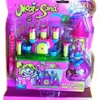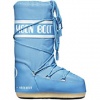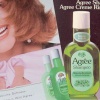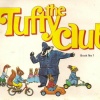Oh, is there anybody who doesn’t miss dear old Woolies? The shop that had everything you could ever want, all in one place, whether it was stationery, clothes, cheap toys, dressing up outfits, kitchen equipment, ironing boards, music or the immense CandyKing Pic ‘n’ Mix – the high street just wasn’t the same when it disappeared.
Despite being a British institution, Woolworths was, of course, originally an American enterprise. Frank Winfield Woolworth founded his business, the F.W. Woolworth Company in Utica, New York, in February 1878. It wasn’t a successful start to his retail career; after the initial flourish of trading the store wasn’t sustainable and it soon closed. Not one to give up, Woolworth found the new location of Lancaster, Pennsylvania and opened up again in July 1879.
With his brother Charles’ help the Woolworths’ brand began to grow and develop across the world; they pioneered the ‘five-and-dime’ concept and ended up becoming one of the biggest retailers of the 20th century – with the sales and customer service techniques that they established still being used to this day.
In 1890 Frank Woolworth travelled to the UK, partly to explore his ancestry in Woolley, Cambridgeshire and partly to buy glassware and china from Stoke on Trent to sell back home. While he was in the country he decided that he could expand the Woolworth’s empire into England. He met up with a clerk who had been recommended by his own idol, John Wanamaker, who had set up his own department stores across the U.S. Woolworth offered the clerk, William Stephenson, the job of director of the new UK arm of his company. Stephenson said yes. Frank then invited some of his existing U.S. store managers to take up the opportunity overseas and in May 1909 they sailed to England to set up F.W. Woolworth & Co., despite reservations from Carson C. Peck, the general manager and vice-president of the American concern.
The first UK Woolies was opened in Church Street, Liverpool on 5 November 1909 to the fanfare of an orchestra, accompanied by fireworks and performers from a circus. Despite being an English store, Frank stuck to the traditions of his home country and no buying was allowed on the first day; it was strictly viewing only. Whilst prospective customers inspected what this new store would sell, they were treated to tea and music from a brass band. The Liverpool Courier gave the shop opening an encouraging evaluation, praising the range of things on offer (as well as their fair pricing of many threepenny and sixpenny goods) and the overall layout of the space. This led to a prosperous first day of trading: there was barely anything left on the shelves by the time the shop closed that day.
By approximately 1939 there were 40 branches of Woolworths throughout Great Britain and Ireland (trading as F.W. Woolworth Ireland) and by 1923 this had increased to 130. William Stephenson oversaw further expansion and FW Woolworth & Co. both bought and built lots of freehold properties to accomplish this (a distinguishing characteristic of many Woolworth’s buildings was the glazed terra-cotta art deco fronts). To illustrate how quickly the Woolworth’s empire was growing, 1930 saw the 400th shop open in Southport, Lancashire but by just four years later there were already 600 outlets, the last opening in Wallington, Surrey. The most stores ever owned by the company occurred at the end of the 1960s; 1,141 were in existence. After this, the amount of branches opening and closing fluctuated over time but that peak was never reached again.
Larger stores were tested in out-of-town areas, trading under the ‘Woolco’ name (also used in both the U.S. and Canada). Never really taking off, some later closed while others were sold to the Dee Corporation at the beginning of the 1980s. These were then transformed into the hypermarket chain, Gateway, and later were taken over by Asda.
In 1982, F.W. Woolworth & Co. and F.W. Woolworth Ireland were taken over by Paternoster Stores Ltd. (later to become Kingfisher plc) – although two years later the decision was taken to close the Irish stores. A finer definition was applied to the categories of stock that the stores sold: confectionery, home, entertainment and children’s toys and clothing (including the Ladybird clothes and Chad Valley toys brands). Also, at this time, many of the largest branches (often the same size as department stores) were moved to smaller locations to ensure profitability.
During the 1990s the Kingfisher Group introduced ‘Big W’ (I – along with everybody else I’ve spoken to who was a fan of Woolies at the time – do not remember this at all!): a chain of 21 megastores that incorporated Woolworths, Comet, B&Q and Superdrug (who were also owned by the group) in one location. In 2002, when Kingfisher sold their ownership, F.W. Woolworth & Co. became Woolworths Group plc and Big W became ‘Woolworths Big W’ who sold only their own products. The Big W chain became obsolete in 2004 with some of the buildings being sold to supermarkets and the others becoming a normal Woolworths.
The 2000s proved to be incredibly tough times for Woolworths in the UK. With shops such as Wilkinson (Wilko) extending their reach into town centres, pound shops becoming popular and supermarkets beginning to sell many similar products, Woolworths began to feel the strain. One of their most lucrative categories was music – I have very fond memories of counting out my change in order to buy a couple of vinyl singles from Woolies on a Saturday afternoon – but an increasing popularity in digital music meant that anybody who relied on selling physical copies found themselves in definite trouble. This also led to the ruin of the nation’s beloved Our Price: I used to love standing at their counter listening to the latest albums on their headphones…sigh.
In 2007 the company introduced ‘WorthIt!’ – a value brand that used mascots Wooly the sheep and Worth the sheep dog (didn’t dig that far into their imaginations to come up with them, did they?), as well as some big name celebrities, to advertise a large range of cut-price products.
In summer 2008 the Woolworth’s board voted against a multi-million pound take-over proposal from Iceland.
The world-wide financial crisis of the late 2000s hit everybody hard and proved to be the beginning of the end for Woolworths as we knew it. Another take-over bid, from Hilco UK, was rejected in November 2008, meaning that both the retail side of the business and subsidiary Entertainment UK (a company that existed to supply music to non-specialist retailers which had belonged to Woolworths Group plc since 2002) were forced into administration with debts of nearly £400 million. The shops kept selling into December, with a closing-down sale beginning on the 11th of that month.
There was a rolling national closure from 27 December and by the 6th January 2009 all 807 branches of Woolworths had closed their doors for good, with 27,000 people losing their jobs. The last few days of the company’s existence saw all their remaining products sell for up to 90% off and many of the shops sold not only all their goods but the shelves, counters and other fixtures too!
The name Woolworths continued online, when www.woolworths.co.uk and the brand name itself was purchased by the Shop Direct Group. It traded on the internet as a retail store from June 2009 until June 2015.
Losing the Woolworth’s name from the UK’s high street was a real blow to many people. Not only because they had grown up with the shop but also because the closure of such a familiar name made everybody realise just how unstable the economy really was at that time. If such a huge corporation as Woolies could disappear then just who else was at risk? (Plenty of well-known brands as it happens but that’s another story…)
And while there were many other places that you could buy value products, Woolworths did it first and – I firmly believe – the best. So much of my pocket money was spent there: music, pick ‘n’ mix, picture frames, art supplies, toys, clothes…you name it, Woolies would be the first place you looked for it.
Farewell Woolies – I’ll never forget you!








Do You Remember Woolworths?
Do You Remember Woolworths?